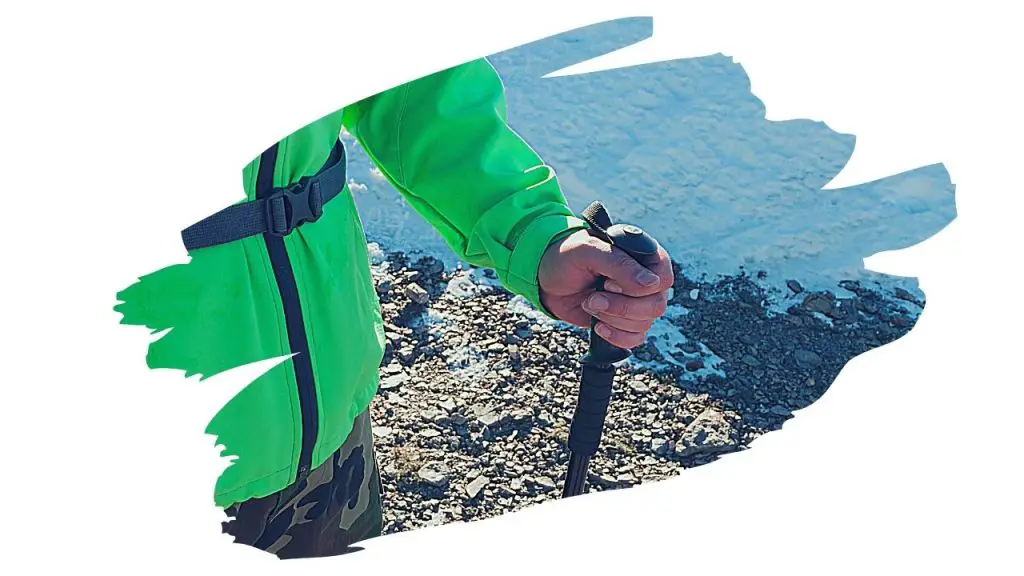If you love to go for long walks, then using a hiking stick will make it easier for you to navigate all of that mountainous rugged terrain.
So, if you’ve decided to craft your very own wooden walking stick, the best way to weatherproof your cane is to seal it with a coat of polyurethane or some other type of finish.
But, just how do you seal a walking stick?
- First, you will need to smooth down the surface of the walking stick by sanding it.
- If the walking stick still has bark on it, you will need to strip off the bark using a coarse sandpaper (40-60 grit).
- After much of the bark has been removed, switch to using a medium grit sandpaper (80 to 120 grit) to smooth the surface level.
- Next, after sanding, it is time to wipe away any loose dirt and dust using a Tack Cloth.
- Now, you can now seal the walking stick using a single coat of polyurethane wood finish.
Just What On Earth Is ‘Tack Cloth’? Almost any bit of rough fabric can be used as a tack cloth. These bits of material are used to remove lint, dirt and dust from the surface of wood.
Still, as you’ve probably guess, there is a little bit more to making a usable walking stick than just slapping on a sealing coat.
And in this article, we are going to look at 5 things you will need to know to make a long-lasting wooden walking stick...

This post may contain affiliate links to products that we receive a commission for (at no additional cost to you). Learn more here.
1 How To Sand A Walking Stick
The first step to sealing a walking stick involves making sure that the surface of the wood is smooth enough to take on the finishing coat.
This is why you will need to strip and sand the surface of the stick before you brush on any sealer.
This step is pretty straight forward. A whittling tool, some coarse sandpaper (40-60 grit range) and some good old manual labor are all you need.
- Prepare the stick for sanding by removing the bark using the whittling tool.
- Debark the stick first, then use very coarse sandpaper (40-60 grit) to scrape away any remaining bark.
- Once that is done, you can begin smoothing the surface using a medium grit sandpaper (80-120 grit).
Now, unfortunately, sanding the walking stick will mean you will have to get rid of a lot of that lovely looking bark.
But what if you didn’t want to remove the bark?
2 Can You Leave The Bark On A Walking Stick?
Yes, you can. And you should still add a sealer coat as well.
Lets say you want to keep the bark, whether for the look of it, or simply because the bark won’t peel off easily enough. In which case, you can still seal the bark using a finishing spray.
So, how do you preserve bark on a walking stick?
A finishing spray, such as Minwax 33055000 Fast-Drying Polyurethane Aerosol will safeguard the bark for you.
Better yet, it will give you a much better and more evenly spread sealant coverage than using a brush.
And it will be easier to get the sealant into all of those hard to reach notches and nooks (certainly easier than if you’d simply used a paint brush).
You can find the latest prices for Minwax Fast-Drying Polyurethane Aerosol on Amazon.
3 What Is The Best Finish For A Walking Stick?
For a walking stick, (an item that will likely be used outdoors a lot), you should use a high quality oil-based polyurethane product, (instead of a water-based finish).
This is because water-based finishes are less durable than their oil-based counterparts.
Now, in all honesty, both finish types offer good water-proofing and protection. However, oil-based polyurethane has a higher VOC content (Volatile Organic Compounds).
VOC’s is the stuff that causes oil-based poly to give off those strong fumes. It is also the stuff that makes oil-based polyurethane last so long.
On the other hand, water-based poly has a much lower VOC content level (and gives off very little odor as a result). But, it doesn’t last very long compared to its oil-based counterpart.
So any quality oil-based polyurethane finish would be ideal for sealing your walking stick.
So which finish do we recommend? Well, it is Minwax to the rescue again with the Minwax 63005444 Fast Drying Polyurethane Clear Finish.
It is super fast drying for an oil finish, and will give your walking stick a glossy look.
You can find the latest prices for Minwax Polyurethane Clear Finish on Amazon.
4 How Do You Waterproof A Walking Stick?
A good coat (or two) of a quality oil-based wood finish is pretty much all you need for this.
Simply use a natural bristle brush to apply the wood finish onto the walking stick all along its length (and end-to-end).
If you are applying a water-based polyurethane coat, then you are better off using a nylon bristle brush instead. The bristles of these brushes don’t soak up the water in the polyurethane the way that a natural bristle brush does.
5 Help! Why Is My Walking Stick Cracking And Splitting?
Well, wood tends to crack as a result of moisture getting into it. You see, wood is pretty much like a sponge. As it soaks up water it expands. And as the wood drys it contracts.
Now, if your walking stick is cracking, then its probably because you didn’t give the wood enough time to fully dry out before sealing it.
And all that moisture in the wood has dried out and warped your walking stick as a result.
It can take a few weeks, (in some cases a few months), for green wood to fully dry out. And even then, you don’t want wood drying out too fast either.
To learn more about how to dry out wood, (so you need never worry about cracks appearing in your walking sticks again), then click here to read: How Long Does It Take Wood To Dry (Plus 5 Quick Tips).
Final Thoughts
Keeping your hiking stick – or a simple everyday walking cane – in tip top condition for years is pretty simple.
Seal the wood and let that top coat layer take care of your walking stick, so that your walking stick can take care of you.
When you seal your walking stick, just be sure to;
- Remove the bark and sand down the surface of the walking stick using 80-120 grit sandpaper.
- If you want to keep the bark on the walking stick, then use a finish spray rather than a brush to apply the wood finish.
- Seal the wood with an oil-based polyurethane rather than a water-based finish (for better protection).



